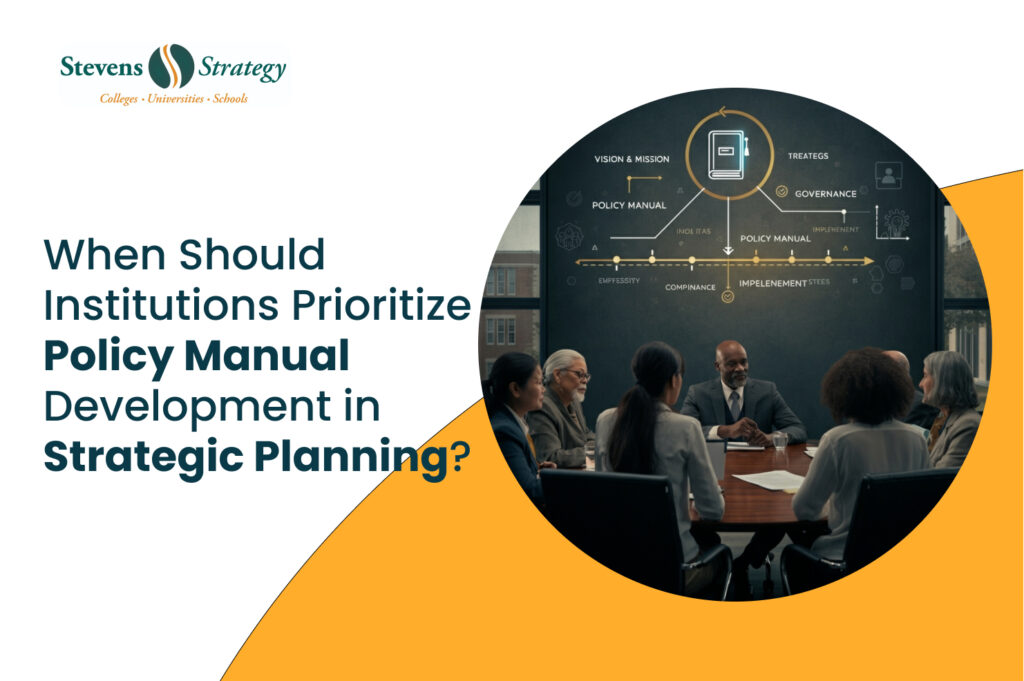By Jack Corby
Monday, September 22, 2025

Policy manuals are the constitutional texts of higher education. They define the grammar of governance, the parameters of compliance, and the ethos of institutional culture. To treat them as mere paperwork is to miss their strategic weight: a policy manual is both a handbook for daily operations and a charter for institutional continuity. Far from static binders, manuals are living documents: evolving alongside strategy, sustaining academic rigor, and reinforcing institutional credibility.
The challenge for leadership is not whether to invest in policy manual development, but when. Timing is the hinge on which governance integrity rests. Integrated too late, manuals devolve into reactive compilations. Positioned within the strategic planning cycle, they become instruments of foresight by unifying stakeholders, codifying standards, and embedding accountability into the very architecture of decision-making.

This blog examines the precise moments when educational policy manual creation becomes mission-critical during accreditation reviews, academic expansion, leadership transitions, or structural reorganization.
The Intellectual and Strategic Role of Policy Manuals
Governance Transparency
Accrediting bodies such as the AAC&U and CHEA underscore a central principle: transparency is inseparable from effective governance. Policy manuals serve as the primary medium through which that transparency is achieved, ensuring that expectations are not implied but explicitly articulated.
Institutional Philosophy in Practice
Policy manuals transform abstract values into operational standards. Through university regulations drafting, institutions set expectations that guide faculty, staff, and students with clarity and consistency.
Continuity and Safeguards
Leadership transitions, programmatic innovations, and structural changes inevitably create uncertainty. Manuals safeguard against fragmentation by codifying procedures that outlast individuals and prevent institutional drift.
Living Architecture
Manuals should evolve alongside strategic priorities. Engaging Higher Education Handbook consulting experts ensures these documents adapt to accreditation cycles, program innovations, and new governance models, making them responsive rather than static.
When Policy Manual Development Becomes Urgent
Institutions encounter moments where deferring documentation compromises governance. At these points, policy manual development shifts from routine upkeep to a strategic necessity.

Accreditation and Compliance Reviews
- Accrediting bodies such as CHEA, HLC, and SACSCOC require explicit documentation.
- Strong manuals provide academic compliance documentation that meets accreditation standards with clarity and transparency.
Expansion of Academic Programs or Modalities
- New offerings, credentials, accelerated degrees, and online delivery demand redefined expectations.
- School policy development ensures academic rigor holds firm as innovation broadens the curriculum.
Leadership Transitions
- Incoming presidents, provosts, or deans need structured frameworks to understand the organization, guide decisions, and help chart a successful path for the institution.
- Codified policies establish continuity, assuring faculty and staff that governance does not drift with leadership change.
Institutional Mergers or Structural Reorganization
- Reorganization introduces complexity and potential contradictions.
- Manuals create institution-wide cohesion, providing a single reference point that preserves governance integrity across constituencies.
Benefits of Proactive Policy Manual Development

Intellectual Efficiency: From Confusion to Clarity
In many universities, policies live in scattered memos, aging faculty handbooks, or unwritten traditions that only a few long-serving staff can recall. This fragmentation breeds conflict: two committees might interpret tenure procedures differently, or departments might apply grading appeals inconsistently. Every time leaders meet, they spend more energy debating which rule applies than solving the issue at hand.
Proactive policy manual development transforms this environment. By consolidating expectations into a single, authoritative reference, institutions create clarity. Committees work from the same framework, leaders spend less time untangling procedural knots, and faculty gain confidence that decisions follow the same standards across campus. The manual becomes less a binder on a shelf and more a shared language for governance.
Governance Credibility: Building Trust That Endures Scrutiny
Trustees, accreditors, and faculty all judge institutions not only on outcomes but also on how decisions are made. Without transparent documentation, governance can appear improvised—even if leaders act in good faith. In high-stakes contexts like accreditation, that appearance can weaken credibility.
When universities embed compliance-informed planning into manuals, they demonstrate that decision-making rests on established processes, not shifting preferences. For accreditors, this signals readiness and accountability. For trustees, it provides confidence that institutional risk is managed responsibly. For faculty, it reaffirms shared governance. The manual becomes proof that the institution’s credibility is more than rhetorical—it is documented, accessible, and defensible.
Institutional Memory: Safeguarding Continuity Through Change
Universities change leadership more often than most realize. A president retires, a provost accepts another role, or a dean moves on. With every transition, undocumented practices risk fading into ambiguity. New leaders arrive asking: How did we handle program approval before? What are the standing rules for faculty promotion? If answers vary depending on who you ask, continuity breaks down.
Proactive educational policy manual creation prevents this cycle. Manuals preserve institutional memory, recording the practices that define governance. When new leaders step in, they inherit a coherent framework rather than a patchwork of precedent. Faculty know that standards do not evaporate with leadership change. Over time, the manual becomes not only a governance tool but also an archive of the institution’s evolving identity.
Stevens Strategy’s Approach to Policy Manual Development
When we partner with a college or university, we don’t start by writing policies. We begin by listening. Our team consults with faculty, administrators, and trustees to learn how decisions are currently made, identify where conflicts occur, and determine which traditions should be maintained. Every institution has its own character, and we make it a point to respect that before recommending any changes.
From there, we guide the community through a structured process:
- Clarifying governance roles: Together, we define who holds authority, who advises, and how responsibilities are shared. This step alone often clears years of confusion.
- Designing clear procedures: We work with committees to document policies that are fair, practical, and consistent with accreditation standards.
- Building consensus: Our process isn’t just about writing; it’s about bringing people together. Faculty, staff, and leadership all have a voice in shaping the manual.
- Delivering a living document: The final manual is designed for long-term use. It doesn’t sit on a shelf; it’s a resource that institutions can update and rely on for decades.
We take pride in knowing that what we deliver isn’t just a policy manual. It’s a framework for smoother governance, stronger compliance, and lasting institutional stability.
Conclusion
Policy manuals are more than documents; they are instruments of governance that safeguard consistency, accountability, and transparency. As AAC&U and CHEA remind us, institutions succeed when governance is intentional and aligned with their mission. Delaying this work risks eroding both trust and effectiveness.
An institution that delays policy manual development delays its own capacity to govern with clarity and integrity. The most successful colleges and universities are those that embed policy manual creation directly into their strategic planning cycles—making governance a proactive measure, not a reactive fix.
We bring decades of expertise in policy manual development and higher education strategic planning. From accreditation readiness to organizational restructuring, we help institutions document, clarify, and strengthen their governance practices. Let us guide your institution toward stability, compliance, and long-term success.
